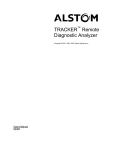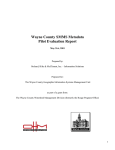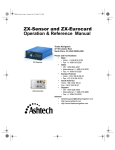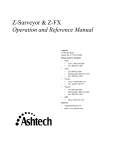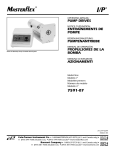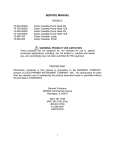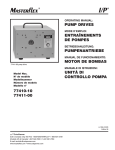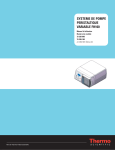Download Digi-Sense 60010-85 Specifications
Transcript
Digi -Sense ® DataLogR RTD THERMOMETER MODEL NO. 60010-85 Digi -Sense ® Eutech Instruments Pte Ltd Blk 55 Ayer Rajah Crescent #04-16 Singapore 139949 Tel: (65) 6778 6876 Fax: (65) 6773 0836 Website: www.eutechinst.com email: [email protected] 68X309913 Rev.1.1 02/03 CERTIFICATE OF CONFORMANCE This thermometer was calibrated using equipment traceable to the National Institute of Standards and Technology (NIST). This instrument conforms to DIN IEC-751 revised to ITS-90. The accuracy of the thermometer at the time of calibration was within specifications stated in the operating manual. Model No.:__________________________ Serial Number:______________________ Date placed in service:________________ To purchase an NIST certificate of traceability with test data and test date for meter and probe, please contact your dealer or: Barnant Company 28W092 Commercial Avenue Barrington, Illinois USA 60010-2392 Toll-free: 800-637-3739 INTRODUCTION This versatile hand-held instrument provides highly accurate temperature measurements in Celsius or Fahrenheit using a 100 ohm platinum RTD, with an alpha of 0.003850 or 0.003916. This instrument covers the extended measuring range of –200 to 1210 °C (–328 to 2210°F). The instrument is designed for easy operation and includes the following features: • Operator selection of temperature scale • Resolution of 0.01° from –50.00°C to 99.99°C (–58.00°F to 99.99°F) • LCD with three four-digit displays • 3-pin circular connector input (mate to Switchcraft TA3F plug) • Hold feature for temporarily retaining a reading • Two-point field calibration capability • Low battery warning • Stores or logs up to 1000 readings with real-time markers 1 • Scrolls through all stored readings • Displays MIN and MAX readings • Interfaces with optional HEWLETT PACKARD® infrared printer or optional RS-232-C adapter • Prints temperature and time of reading • Built-in tilt stand for easy hands-free operation SAFETY PRECAUTIONS VOLTAGES PRESENT AT DANGER THE RTD MAY ALSO BE PRESENT AT THE BATTERY TERMINALS. ALWAYS DISCONNECT THE RTD WHEN CHANGING BATTERIES. WARNING THIS INSTRUMENT IS DESIGNED TO ACCEPT LOW LEVEL SIGNALS SUPPLIED BY STANDARD 100 OHM PLATINUM RTD’S. UNDER NO CIRCUMSTANCES SHOULD THE INPUT VOLTAGE EXCEED THE SPECIFIED 10 V RMS. DO NOT USE OR STORE THIS INSTRUMENT IN MICROWAVE OVENS OR ANY ABNORMALLY HOT OR COLD AREAS. CAUTION WEAK BATTERIES SHOULD NOT BE LEFT IN THE INSTRUMENT. DEAD BATTERIES CAN LEAK AND CAUSE DAMAGE TO UNIT. CAUTION 2 EU Declaration of Conformity Name of Apparatus: RTD Logger Model Number: 60010-85* Description of Apparatus: Electronic thermometer using an RTD probe Barnant Company declares that the above model is in conformity to the following harmonized standards and directives: Applicable Applicable Directives Specifications 73/23/EEC 93/68/EEC Manufacturer’s Report Number EN61010-1/A2: 1995 TR0076 89/336/EEC EN61326-1/A1: 1998 TR0076 92/31/EEC 93/68/EEC The last two digits of the year in which the current configuration of the above model was assessed per the Low Voltage Directive is :00. *Evaluated for EMC as part of a system using the AC Adapter, Model Number 600-0075. Manufacturer: Barnant Company Division Cole-Parmer Instrument Company 28W092 Commercial Avenue Barrington, IL 60010-2392 USA Tel.: 847-381-7050 Manufacturer’s Signature: 19 December, 2000 James W. Doll Vice President, Engineering 3 Date SPECIFICATIONS RTD PROBES Impedance: 100 ohm @ 0°C (32°F) Sensitivity (alpha): 0.003850 or 0.003916 ohm/ ohm/°C selectable Accuracy: ±0.06°F; ±0.03°C at 0.01° resolution ±0.1° at 0.1° resolution ±1° at 1° resolution LOGGER Linearization: Conforms to DIN IEC 751, revised to ITS-90 Input Protection: 10V rms Display Update: 0.6 seconds per update Connector: 3-pin circular connector input (mate to Switchcraft TA3F plug) Battery Size: Two AA, 1.5V alkaline ANSI-L40, IEC-LR6 Life: >300 hours continuous, typical Display: LCD with 0.4 in high characters main readout and 0.2 in high characters secondary displays, 4 digits each display plus various annunciators. Temperature/Humidity Range Operating: Stated Accuracy: 10°C to 40°C (50°F to 104°F) 0°C to 40°C (32°F to 104°F) –10°C to 60°C (–14°F to 140°F) 10% to 90% (non-condensing) Useful Range: Storage: Humidity: 4 Dimensions 3 cm D x 8.4 cm W x 15.8 cm H (1.2 in x 3.3 in x 6.2 in) Weight with batteries: 227 grams (8 ounces) Ingress protection: Meets IEC-529 IP-54 for dust and water resistant enclosures. Compliance: For CE Mark: EN61326-1/A1: 1998 (EU EMC Directive) 5 BATTERY INSTALLATION AND REPLACEMENT VOLTAGES PRESENT AT DANGER THE RTD MAY ALSO BE PRESENT AT THE BATTERY TERMINALS. ALWAYS DISCONNECT THE RTD WHEN CHANGING BATTERIES. WEAK BATTERIES SHOULD NOT BE LEFT IN THE INSTRUMENT. DEAD BATTERIES CAN LEAK AND CAUSE DAMAGE TO UNIT. CAUTION 6 If battery indicator turns on, battery life is approximately 8 to 10 hours. The battery indicator will start blinking with less than 1 hour of life remaining. AT THIS POINT, BATTERY MUST BE CHANGED. IF BATTERY VOLTAGE GOES TOO LOW, DISPLAY WILL GO BLANK. See SPECIFICATIONS for battery type. 1. Before changing battery, turn instrument off and disconnect probe. 2. Loosen screw and lift battery cover off back of case. 3. Remove the two AA batteries. 4. Insert two new batteries, observing polarity. 5. Install cover and tighten screw. AC ADAPTER An optional AC adapter can be used for power to conserve batteries. The adapter is not a charger and will not charge batteries. The adapter connects to the bottom of the thermometer. When the adapter is connected, the batteries are disconnected. Refer to the ACCESSORIES section for adapter information. 7 CONNECTING AN RTD Note: Be sure your instrument setting matches the RTD you are using (alpha of 0.00385 or 0.003916). See SELECTING RTD SENSITIVITY (ALPHA) on page 14. Insert the 3-pin plug into the mating connector on the top of the instrument. 8 9 10 11 QUICK SETUP Note: Review SAFETY PRECAUTIONS on page 3. 1. Install batteries. 2. Connect RTD probe. 3. Press the ON/OFF key. The thermometer performs a self-test and all display digits and indicators, as shown below, should remain on for approximately one second. The clock will remain on for about three seconds. 4. Use SETUP to select the correct sensitivity (ALPHA) and various other options. Use ▲ or ▼ to make selections, to enter selections and go to next step. 12 If a probe has not yet been connected to the instrument, you will see this display: This message also appears if a probe is broken. No measurements can be made while this warning is displayed. RESET FACTORY DEFAULTS Press and hold CLEAR and SETUP at power on until “CLr” shows in the display. Then release CLEAR and SETUP. Press any key to continue. 13 COMPLETE SETUP PROCEDURE The setup function scrolls through a series of steps for selecting probe sensitivity (alpha), resolution, filter rate, setting the real-time clock, selecting the line frequency and accessing the Log sub-menu and the Print sub-menu. Either the complete setup can be run as described below, or the setup can be initiated and terminated at any step. The Log sub-menu and the Print sub-menu can be accessed without going through the complete setup. These variations are covered in the following procedures. NOTE Settings selected in the Setup procedure are stored in memory and will remain even after power is turned off or while batteries are being replaced. Press the SETUP key. The lower left display will show either the time of day or “OFF” and it will be flashing. SELECTING LOWER DISPLAY MODE Press the MAX ▲ key or MIN ▼ key to toggle the lower display between showing the time of day and showing minimum and maximum temperature key to advance to the values. Press the HOLD next step in the setup sequence. SELECTING RTD SENSITIVITY (ALPHA) Press the MAX ▲ key or MIN ▼ key to select either 0.003850 (3850 flashing) or 0.003916 (3916 flashing). The lower left display will read “ALPH”. When correct RTD sensitivity is flashing, press the HOLD key to advance to the next step in the setup sequence. TEMPERATURE RESOLUTION There are three choices for temperature resolution. The first choice is with 0.01° resolution selected: the thermometer will automatically range to show 14 the greatest possible resolution. The next choice is 0.1° resolution: the thermometer will automatically range between 0.1° and 1° as required. The final choice is 1° resolution: the display will remain in this resolution for all displayed temperatures. When 0.01° or 0.1° resolution is selected, a decimal point will appear in the upper numerical display. When 1° resolution is selected, no decimal point will be present. The upper display will show 0.01, 0.1 or 1 and it will be flashing. Press either MAX ▲ key or MIN ▼ key to change resolution, then press the HOLD to advance to the next step in the setup sequence. FILTER RATE The filter rate can be set to OFF, Lo or Hi. This rate is changed to smooth out fluctuations in the readings. Normally this would be set to OFF. If readings are unstable, try changing to Lo or Hi. The lower left display will read “FILt” and the upper display will flash either OFF, Lo or Hi. Use the MAX ▲ key or MIN ▼ key to switch the filter rate, then press HOLD key to store the rate and continue setup by setting the real-time clock. SETTING REAL-TIME CLOCK 1. When setting the real-time clock, the right two digits in the lower left display will be flashing. Use the MAX ▲ key or MIN ▼ key to adjust the flashing digits to the desired minute setting. 2. Press HOLD key to lock in the minutes and advance to the hours setting. Hours are set in the 24 hour time system. Therefore, time after 12:59 pm requires 12 to be added to the time. For example, 3:00 PM is (3+12) = 15:00 hours. 15 3. The left two digits in the lower left display will be flashing. Use the MAX ▲ key or MIN ▼ key to adjust the flashing digits to the desired hour setting. key to store the hours and 4. Press the HOLD advance to the month setting. 5. The MO annunciator will be on and the left two digits in the lower right display will be flashing. Use the MAX ▲ key or MIN ▼ key to adjust the flashing digits to the desired month setting (1 to 12). 6. Press the HOLD key to store the months and advance to the day setting. 7. The DAY annunciator will be on and the right two digits in the lower right display will be flashing. Use the MAX ▲ key or MIN ▼ key to adjust the flashing digits to the desired day setting (1 to 31). 8. Press the HOLD key to store the day and advance to the year setting. 9. The YR annunciator will be on and the two digits in the lower left display will be flashing. Use the MAX ▲ key or MIN ▼ key to adjust the flashing digits to the desired year setting (2000 to 2063). 10. Press the HOLD key to lock in the year. To set up the log or print functions proceed to the following paragraphs. LINE FREQUENCY SELECTION For maximum noise rejection, it is possible to select one of two line frequency settings. This selection should be based on the local mains power line frequency of either 50 Hz or 60 Hz. For example, all of North America is 60 Hz, while Europe is 50 Hz. 16 The lower left display will show “LINE” while the upper display is flashing either 50 or 60. Use the MAX ▲ key or MIN ▼ key to adjust the flashing digits to the desired line frequency setting. key to lock in the line Press the HOLD frequency. This completes the basic operation setup and returns to normal operation. LOG SETUP The Log sub-menu is used to set the time intervals between the logged readings. The time can be set from 1 second to 60 minutes. Once the log sub-menu is setup, logging can be toggled ON or OFF by pressing the LOG key. When logging is turned ON, it will continue until turned OFF or 1000 logs have occurred at the entered rate. The first 1000 logs are retained. 1. Anytime while in SETUP, press the LOG key. The LOG annunciator will be on and the presently set time interval (default is one second) will be displayed in the lower left display. The two right digits represent seconds and will be blinking. 2. Use the MAX ▲ key or MIN ▼ keys to adjust the “seconds” as desired. Press the HOLD key to store setting and advance to “minutes” setting. 3. Use the MAX ▲ key or MIN ▼ keys to adjust the “minutes” as desired. Press the HOLD key to store setting. This completes the Logging setup. 17 PRINT SETUP The Print sub-menu is used to set the time intervals between the readings being sent to the printer. The default rate is once every three seconds. The time can be set from 3 seconds to 60 minutes. Once the print sub-menu is setup, printing can be toggled ON or OFF by pressing the PRINT key. In addition, the data rate for the infrared RS-232-C output can also be set. 1. Anytime the PRINT key is pressed while in SETUP, the PRINT annunciator will be on and the presently set time interval (default is three seconds) will be displayed in the lower left display. The two right digits represent seconds and will be blinking. 2. Use the MAX ▲ key and/or MIN ▼ keys to adjust the “seconds” as desired. Press the HOLD key to store setting and advance to the “minutes” setting. 3. Use the MAX ▲ key and/or MIN ▼ keys to adjust the “minutes” as desired. Press the HOLD key to store setting and proceed to the data output rate. 4. Use the MAX ▲ key and/or MIN ▼ keys to scroll through the available data output rates of HP, 300, 600, 1200 or 2400 (use HP for the HEWLETT-PACKARD infrared printer). Press the HOLD key to store setting and end the setup. The data output rates of 300, 600, 1200 and 2400 are for use with the optional infrared to RS-232-C adapter. SELECTING INDIVIDUAL PARAMETERS The RTD sensitivity, resolution, filter update rate, real-time clock and line frequency can be set individually without performing the complete setup. First press the SETUP key, then repeatedly press the HOLD key until the desired function is displayed. Use the ▲ ▼ keys to change the function and press the HOLD key to store setting. 18 OPERATING PROCEDURES The unit will always power up with the upper display showing temperature. If a probe is not connected at power up, the upper display indicates OPEN. For optimum operation, allow about one minute for ambient temperature stabilization. If the unit has been stored at an extreme ambient condition, more time may be needed. BASIC TEMPERATURE MEASUREMENTS Check that the thermometer is turned on, the probe connected, the desired resolution 0.01° or 0.1° or 1° is selected, and the desired scale °F or °C is selected. SELECTING THE TEMPERATURE SCALE Use the °C/°F key for selection of the Fahrenheit or Celsius scale. The last selection is retained in memory even if power is switched off. MAXIMUM READINGS The maximum reading function displays the maximum reading since power up or since the last time the clear function was used. The maximum reading function is ideal for monitoring unattended operations while continually displaying every temperature change that occurs. The maximum and minimum values are sensed and automatically stored until you are ready to observe the reading. Do not turn the instrument OFF when a maximum or minimum temperature value may be needed; MAX/MIN memory contents will be lost. 19 Clearing a Maximum Reading Press the CLEAR key then press the MAX ▲ key. The maximum memory will be cleared. MINIMUM READINGS The minimum reading function displays the minimum reading since power up or since the last time the clear function was used. While continually displaying every temperature change that occurs, the maximum and minimum values are sensed and automatically stored until you are ready to observe the reading. Do not turn the instrument OFF when a maximum or minimum temperature value may be needed; MAX/MIN memory contents will be lost. Clearing a Minimum Reading Press the CLEAR key then the MIN ▼ key. The minimum memory will be cleared. HOLD FUNCTION key to retain the reading on Press the HOLD the display. Press HOLD key again for normal operation. Maximum Hold Press the MAX ▲ key, then press the HOLD key. To turn off the HOLD function and return to normal operation, press the HOLD key again. To clear the maximum readings, press the CLEAR key, then the MAX ▲ key. 20 Minimum Hold Press the MIN ▼ key, then press the HOLD key. To turn off the HOLD function and return to normal operation press the HOLD key again. To clear the minimum readings, press the CLEAR key, then the MIN ▼ key. STORED READINGS The store function allows you to store up to 1000 readings. Each reading is logged with a storage location number and the time of occurrence. To store readings, proceed as follows: 1. Momentarily press the STORE key. The present temperature is stored. The upper main display will momentarily show the storage location number and the STORE annunciator will be on. After three seconds, the storage number will be replaced with a temperature reading but the STORE annunciator remains on to indicate a temperature reading has been stored. The STORE key may be pressed as fast as once per second. 2. Repeat step 1 for all the points to be recorded, up to a maximum of 1000. Each time the STORE key is pressed, the new reading will be stored and the upper main display will show the storage location number for about 3 seconds. After 1000 stored readings, the next time the STORE key is pressed the main display will indicate FULL. 21 RECALL READINGS This function allows the stored readings, the reading sequence number and the Time/Date of the readings to be recalled. RECALL shows each stored reading individually. When individual readings are recalled, you can toggle between the reading and the sequence number of the reading. To recall readings, proceed as follows: 1. Momentarily press the RECALL key, the time and date will be displayed on the lower displays and the stored sequence number will be displayed on the upper main display. The STORE and RECALL annunciators will be on. 2. To step through the readings, press the MAX ▲ key or the MIN ▼ key. Each press of the key will advance to the next reading in sequence. Hold the MAX ▲ key or MIN ▼ key down to advance continuously through the readings at an increasing rate. To increment or decrement by 100, proceed as follows: To increment, hold down the MAX ▲ key then press the MIN ▼ key. To decrement, hold down the MIN ▼ key then press the MAX ▲ key. 3. To toggle between the readings and the reading sequence number, press the RECALL key again. 4. To return to normal operation, press any other key except ON/OFF, MAX ▲, MIN ▼ or RECALL. CLEARING STORED OR LOGGED READINGS Press the CLEAR key, then the STORE key or LOG key. Regardless of which key is pressed, STORE or LOG, the stored and logged readings in memory will be cleared. 22 LOGGING READINGS The Logging function is controlled by the LOG key. Prior to logging readings, it is necessary to set up the time interval between readings (see LOG SETUP) in the COMPLETE SETUP PROCEDURE section. The time between readings can be set to any value from 1 second to 60 minutes. Logging is initiated by pressing the LOG key. Logging will continue at the programmed rate until either the LOG key is pressed again or 1000 logs have occurred. The display will then show “FULL”. The STORE function can be used during logging to insert additional measurements by pressing the STORE key. PRINTING Printing can output real-time readings or stored readings. The output is sent to the infrared (IR) printer output located at the top of the thermometer. The printer output default time period is once every 3 seconds. This time can be set to any value between 3 seconds and 60 minutes (see PRINT SETUP) in the COMPLETE SETUP PROCEDURE section. The following sample printouts show the RS-232-C format and the HEWLETT-PACKARD infrared printer in normal and log dump print modes. Note that in log dump print mode the first line specifies the total number of readings. The print function is controlled by the PRINT key. 23 Printer Format for Normal Printing New heading will appear when date changes or new print is started. ---- = over range 06/01/00 13:20:54 13:20:57 13:21:00 13:21:03 13:21:06 13:21:09 13:21:12 13:21:15 13:21:18 13:21:21 13:21:24 06/01/00 13:21:27 13:21:30 13:21:33 13:21:36 06/01/00 13:21:39 °F 30.56 32.22 32.44 164.2 -103.1 -58.87 -58.92 510.4 1034 ---1034 °C 556.3 556.8 0.01 0.04 °F 32.05 24 Printer Format for Log Dump New heading will appear when date changes. ---- = over range TOTAL READINGS:1000 02/02/00 °F 19:01:00 ---19:01:02 -321.6 19:01:00 -279.5 19:01:07 -236.7 19:02:19 -192.9 19:01:01 -149.0 19:01:01 -104.2 19:01:03 -58.95 19:01:00 -13.51 TOTAL READINGS:1000 02/02/00 °C 19:01:00 ---19:01:02 -196.4 19:01:00 -173.0 19:01:07 -149.3 19:02:19 -124.9 19:01:01 -100.5 19:01:01 -75.69 19:01:03 -50.53 19:01:00 -25.29 19:01:01 -0.06 19:01:00 25.52 Note that printing 1000 stored sets of readings could take nearly one hour as limited by the printer. 25 RS-232-C Format for Normal Printing and Log Dump ---- = over range “DATE”, “TIME”, “DEGREES F” 07/13/00,16:30:20, 72.56 ,16:30:30, 72.55 ,16:30:40, “OPEN” ,16:30:50,"----" The print function is controlled by the PRINT key. Proceed as follows: 1. Perform the PRINT Setup procedure to set the desired print rate. 2. Check that the IR printer input is properly aligned with the infrared output at the top of the thermometer. 26 Printer output will occur in real-time when the thermometer is operating in the normal mode. When the thermometer is in the RECALL mode, printing of the stored information will occur. 3. Press the PRINT key to start printing. Printing will continue at the programmed print rate until the PRINT key is pressed again, or if stored data is being printed and all data has been transferred to the printer. When printing stored data, the temperature and times of occurrence will be output. CALIBRATION The calibration function allows both single point and dual point calibration of the thermometer. Single point calibrates the offset only. Dual point calibrates the offset first then calibrates the slope. The thermometer can be calibrated at any temperature. It is not necessary to perform a field calibration to obtain specified accuracies. Use the field calibration feature to improve thermometer/probe accuracy or to compensate for probe calibration drift. The thermometer has a memory retention capability to hold calibration values even while power is off or the battery is removed. When you restart, there is no need to recalibrate. NOTE The temperature at which water boils (100°C/ 212°F) is at sea level and standard atmospheric pressure using distilled water. Changes in altitude and barometric pressure will cause the boiling temperature to change. As a rule of thumb, the boiling temperature of water will decrease 1°C (1.8°F) for every 1000 feet above sea level. For example, at an elevation of 5300 feet (1600 meters), water will boil at approximately 94.7°C (202.5°F). 27 Other liquids may also be used as calibration standards. Consult a chemical handbook for their freezing (melting) point and boiling point properties. When calibrating at freezing (0°C or 32°F), it is recommended to use crushed ice made of distilled water in a dewar flask. Add crushed ice to top of flask. Top off flask with distilled water. Continue to add crushed ice to maintain tightly packed crushed ice/water in flask. CALIBRATION PROCEDURES Calibration Procedure This calibration function provides for both an offset and slope field calibration. For proper calibration, the following conditions must be observed: • The slope point must be a higher temperature than the offset point. • The difference must be at least 20°C (68°F). • Use two points based on the expected high and low temperatures. Temperatures measured outside of these limits may no longer meet specifications. • Resolution is based on the selected display resolution. Proceed as follows to calibrate the probe. 1. Place the probe at the lower known reference temperature. 2. Offset Calibration: Momentarily press the CAL key to enter the calibration mode, the CAL annunciator will flash. The temperature is displayed on the main display and Lo is displayed on the lower left display. “Lo” signifies that this is the offset point. 28 3. Allow the reading to stabilize. If the displayed temperature is higher or lower than the reference temperature, use the MAX ▲ key to increase the displayed reading or the MIN ▼ key to decrease the displayed reading until the reference temperature is displayed. The MIN ▼ or MAX ▲ must be pressed at least once. The CAL annunciator should be blinking during this procedure. key to lock the offset 4. Press the HOLD calibration in and advance to the slope calibration. To return to normal operation, press any key except CAL or HOLD . 5. Slope Calibration: Place the probe at the higher reference temperature. 6. Allow the reading to stabilize. If the displayed temperature is higher or lower than the reference temperature, use the MAX ▲ key to increase the displayed reading or the MIN ▼ key to decrease the displayed reading until the reference temperature is displayed. The MIN ▼ or MAX ▲ key must be pressed at least once. The CAL annunciator should be blinking during this procedure. 7. Press the HOLD in. key to lock the calibration Clearing Cal Point: Press CLEAR, then CAL. Unit reverts to factory calibration with no offset or slope compensation. FIELD CALIBRATION LOCKOUT AND RE-ENABLE The calibration lockout feature prevents any field calibration changes. The lockout remains in effect until a lockout re-enable has been performed. Use the following procedures to lockout or re-enable the field calibration operation. 29 Lockout Procedure 1. Turn the thermometer off. 2. Simultaneously press and hold the CAL and the CLEAR keys down and momentarily press the ON/OFF key. Continue to hold the CAL and CLEAR keys for at least 5 seconds. Re-Enable Procedure 1. Turn the thermometer off. 2. Simultaneously press and hold the HOLD and the CAL keys down and momentarily press the ON/OFF key. Continue to hold the HOLD and CAL keys until the display blanks. MAINTENANCE AND TROUBLESHOOTING Properly used, the thermometer should maintain calibration indefinitely and not require service other than occasional cleaning of the housing and changing of the batteries. Do not clean with abrasives or solvents. Use mild detergents, never immerse nor use excessive fluid. BATTERIES If there is no display when the thermometer is turned on, check condition of the two AA batteries. Also check that the battery terminals are clean and batteries are properly installed. If replacement is necessary, refer to the BATTERY INSTALLATION AND REPLACEMENT section for replacement procedure. The real-time clock will keep time for up to 1 minute with the batteries removed. To minimize the need for resetting the clock, either remove and replace one battery at a time, or connect the AC adapter 30 while changing the batteries. All stored/logged readings are retained until cleared, even if the batteries are removed for long periods. SERVICE There are no internal adjustments or user replaceable parts. If “Err” followed by the numbers 1 through 9 is displayed (see example below), return unit for service. Note that “Err” alone may be displayed during improper field calibration. Note: Serial number label is located inside battery compartment. 31 TROUBLESHOOTING The following chart lists the most probable faults. There are no internal adjustments or userreplaceable parts. If this does not solve the problem, refer service to your dealer. FAULT ACTION No display when turned on Check condition of batteries. Check that batteries are inserted properly. Check operation using AC adapter. Display shows ---- Out of range indication. Display shows OPEn Open probe connection. Display shows Err If displayed at any time other than during field calibration, return instrument for service. If “Err 1” through “Err 9” remains on the display, return instrument for service. A-1925-40 Printed in Singapore 020501 68X309913 Rev. 1 01/03 32 WARRANTY The Manufacturer warrants this product to be free from significant deviations from published specifications. If repair or adjustment is necessary within the warranty period, the problem will be corrected at no charge if it is not due to misuse or abuse on your part as determined by the Manufacturer. Repair costs outside the warranty period, or those resulting from product misuse or abuse, may be invoiced to you. The warranty period for this product is noted on the Warranty Card. PRODUCT RETURN To limit charges and delays, contact the seller or Manufacturer for authorization and shipping instructions before returning the product, either within or outside of the warranty period. When returning the product, please state the reason for the return. For your protection, pack the product carefully and insure it against possible damage or loss. Any damages resulting from improper packaging are your responsibility. TECHNICAL ASSISTANCE If you have any questions about the use of this product, contact the Manufacturer or authorized seller. HEWLETT PACKARD — Reg TM Hewlett-Packard Co. TEFLON — Reg TM E.I. DuPont de Nemours and Company Trademarks bearing the ® symbol in this publication are registered in the U.S. and in other countries. A-3477-78 Printed in Singapore 020501 68X309913 Rev. 1 01/03



































